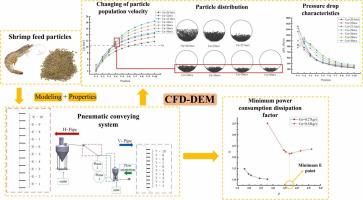Aquacultural Engineering ( IF 4 ) Pub Date : 2023-06-22 , DOI: 10.1016/j.aquaeng.2023.102347 Junping Song , Teng Wang , Guosheng Hu , Zijie Zhang , Wenjie Zhao , Zepeng Wang , Yuangang Zhang

|
Based on the CFD-DEM coupling method, this paper explores the dilute phase pneumatic conveying characteristics of shrimp feed particles. Furthermore, an experimental platform is established to verify the accuracy of the model. The simulated pipeline structure consists of a long horizontal pipe with horizontal bends and long vertical pipe with vertical bends. The results demonstrate a non-linear relationship between the pressure drop of the vertical pipeline and the inlet wind speed. Initially, the pressure drop decreases as the inlet wind speed increases, but it eventually starts to increase. When the inlet wind speed is not less than 18 m/s, the pressure drop of the horizontal pipeline increases with an accelerated inlet wind speed. The optimal inlet wind speed for adult shrimp farming is 24 m/s, while that for juvenile shrimp farming is 21 m/s. A correlation between system energy consumption and solid-gas ratio has been constructed. The ideal solid-gas ratio for adult shrimp farming is 3.69, while that for juvenile shrimp farming is 1.9–2.75. The solid-gas ratio and particle distribution at the inlet section of the straight pipe have a significant impact on the pressure drop characteristics. Their variation with the conveying wind speed directly influences the pressure drop patterns observed in the initial section of the straight pipe. This paper’s findings offer valuable scientific and practical insights for the dilute phase pneumatic conveying of shrimp feed particles, providing guidance for effective and efficient processes in this domain.
中文翻译:

气力输送系统中虾颗粒饲料的输送特性及最小功耗损耗因数
基于CFD-DEM耦合方法,探讨了虾饲料颗粒的稀相气力输送特性。此外,还建立了实验平台来验证模型的准确性。模拟管道结构由带有水平弯头的长水平管道和带有垂直弯头的竖直长管道组成。结果表明,垂直管道的压降与入口风速之间存在非线性关系。最初,压降随着入口风速的增加而减小,但最终开始增加。当入口风速不小于18 m/s时,水平管道的压降随着入口风速的加快而增大。成虾养殖最佳入口风速为24 m/s,幼虾养殖最佳入口风速为21 m/s。构建了系统能耗与固气比之间的相关性。成年虾养殖的理想固气比为3.69,幼虾养殖的理想固气比为1.9~2.75。直管入口段的固气比和颗粒分布对压降特性有显着影响。它们随输送风速的变化直接影响在直管初始段观察到的压降模式。本文的研究结果为虾饲料颗粒的稀相气力输送提供了有价值的科学和实践见解,为该领域有效和高效的工艺提供了指导。幼虾养殖则为1.9-2.75。直管入口段的固气比和颗粒分布对压降特性有显着影响。它们随输送风速的变化直接影响在直管初始段观察到的压降模式。本文的研究结果为虾饲料颗粒的稀相气力输送提供了有价值的科学和实践见解,为该领域有效和高效的工艺提供了指导。幼虾养殖则为1.9-2.75。直管入口段的固气比和颗粒分布对压降特性有显着影响。它们随输送风速的变化直接影响在直管初始段观察到的压降模式。本文的研究结果为虾饲料颗粒的稀相气力输送提供了有价值的科学和实践见解,为该领域有效和高效的工艺提供了指导。它们随输送风速的变化直接影响在直管初始段观察到的压降模式。本文的研究结果为虾饲料颗粒的稀相气力输送提供了有价值的科学和实践见解,为该领域有效和高效的工艺提供了指导。它们随输送风速的变化直接影响在直管初始段观察到的压降模式。本文的研究结果为虾饲料颗粒的稀相气力输送提供了有价值的科学和实践见解,为该领域有效和高效的工艺提供了指导。



























 京公网安备 11010802027423号
京公网安备 11010802027423号